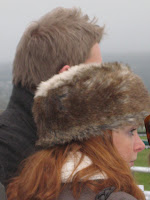
Late 1700s
This Court gown from the 18th century is said to have been worn byAnn Fanshawe whose father was the Lord Mayor of London in 1752-53. The pattern of barley and hops represents her fathers profession as a merchant and Master of the Brewers' Company.
The skirts shape can be attributed to panniers which were constructed from bone. The low neck and elbow-length sleeves with engageants (ruffles on the sleeve) were both typical of court dressing for the time.


World War II
The image on the left is a bus conductress' uniform and reflects the role of women in the work place during World War II. The image on the right is from the same time period but worn by women during day time outings. This particular one was worn to a parade celebrating the end of WW II. While their purposes may have been different, both outfits represent trends of the time such as the emphasized waist, rounded shoulders and raised hemline.

Early 1960s
The magenta dress on the right is by Sam Sherman's label Dollyrockers which was sold at the major boutiques of the decade such as Bus Stop and Top Gear. The yellow shirt and black mini skirt ensemble toward the back of the image was a classic look for young girls in the 1960s. Hemlines were shorter than ever and reflected the belief in freedom that came to define the decade.

Late 1960s-1970s
The dress on the left was designed by the fashion group The Fool which was led by Marijke Koger in 1967. The dress on the right is by Jeff Banks who opened Clobber, an iconic boutique in Blackheath in the 1960s. The dress was worn by Jenifer Spallone in 1969.
The outrageous patterns and loose fit were typical of the time. The mannequin head on the right is wearing a turban which was seen as exotic and risque.


















 The New Years day at Cheltenham Racecourse is a parade of the many styles of British fashion. Yet the most noticeable to a foreigner such as myself were those dressed in "posh" (as my English friend Georgie says) or upscale attire for the horse race in the beautiful English countryside.
The New Years day at Cheltenham Racecourse is a parade of the many styles of British fashion. Yet the most noticeable to a foreigner such as myself were those dressed in "posh" (as my English friend Georgie says) or upscale attire for the horse race in the beautiful English countryside. combination.
combination.